Toilet with vertical outlet: device, pros and cons, installation features
Household comfort is unthinkable without properly functioning plumbing. Choosing and installing a toilet is a sensitive topic, but it needs to be discussed.The improvement of the house and the convenience of living in it for all family members depend on the correct solution of the problem.
Model designs and installation technologies vary. Let's look at how a toilet with a vertical outlet works and how it works and what needs to be taken into account when installing it.
The content of the article:
How to select models based on flush type?
According to statistics, toilets are replaced every 10-15 years. Therefore, it makes sense to take the trouble to find the right model in order to provide yourself with decent living conditions for many years.
Plumbing fixtures differ in many ways:
- bowl shape (visor, dish-shaped, funnel-shaped);
- fastening (floor-mounted, side-mounted, suspended);
- material (porcelain, earthenware, artificial stone);
- flush;
- wastewater discharge (new universal type - vario; usual types: vertical, horizontal, inclined).
Devices are chosen depending on personal preferences, ideas about convenience and aesthetics. As for the type of waste discharge, they focus only on sewerage distribution.
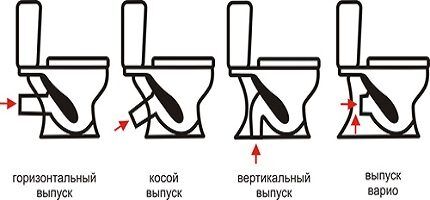
If drastic changes are not planned in the sewerage system, it is better to buy a toilet with the same outlet as the old one.Otherwise, there will be additional costs for reworking the system.
The only universal device is a toilet with a vario release. Such models have appeared recently, they are still difficult to find, but can already be bought in plumbing stores.
The edge of the outlet is located at the maximum possible distance from the rear edge of the device, which makes room for any type of pipe. Another advantage of the vario is the ability to install the toilet close to a partition or wall.
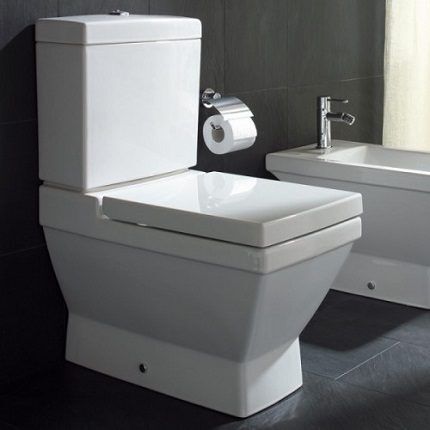
When choosing a model based on the type of release, you should remember that toilets are not interchangeable. Without redesigning the sewerage system, it is impossible to install a device with a vertical outlet instead of a horizontal one, although replacement with an oblique or vario is quite affordable. Ideally, you should buy plumbing fixtures of the same type, otherwise there may be problems not only with installation, but also with operation.
Pros and cons of vertical release
To properly install any plumbing fixture, you need to understand its design features and operating principle. Models with vertical outlet include a siphon and a pipe. These are built-in elements; you do not have to purchase them before installing the device.
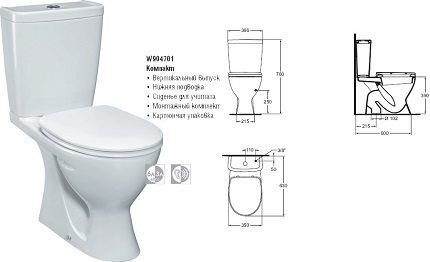
Thanks to the complete set of the toilet, it can be installed anywhere in the bathroom. The devices do not take up extra space, so they can be successfully installed even in very small toilets of small apartments. It is only necessary that the sewer pipe be located in the floor slab.
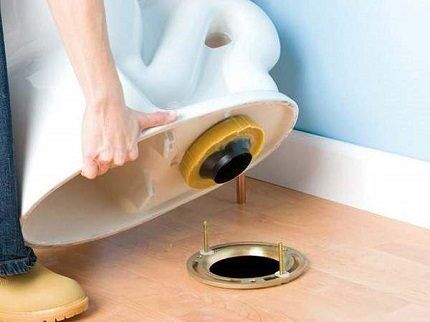
Release to the floor has several advantages:
- Flush efficiency. Wastewater is easily drained into the sewer.
- Layout options. When designing the interior of a bathroom, be sure to take into account the specifics of the sewerage layout. Connecting a toilet with a vertical pipe expands design possibilities.
- Masking of communications. The sewer pipe is located directly under the plumbing fixture. There is no need to look for ways to hide or decorate it.
- Hygiene. Models with vertical flush always have more water than devices with other types of outlet. Thanks to the siphon, waste flows into the pipe faster and better, so the bowl is better cleaned.
- No splashing. Fewer splashes mean you have to clean the toilet less often.
- Reliable tank. Typically, models are equipped with good quality drain tanks.
The drain runs under the floor.If the system is being installed from scratch, this can be difficult because you have to cut a separate hole in a solid concrete slab. If the pipes are already laid, there should be no problems.
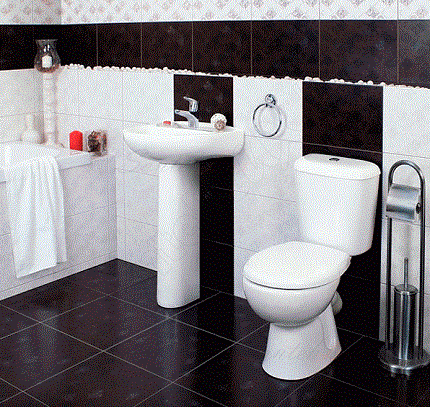
In some houses it is impossible to install appliances with a drain type other than vertical. First of all, this applies to buildings of old construction, for example, Stalinist ones.
An alternative is the release of vario, but with it there are serious installation difficulties. In houses built in recent decades, pipes are laid above floor level. You can install devices with any outlet.
Step-by-step installation instructions
The advantages of models with vertical flush include ease of installation. Even a non-specialist can handle the installation.
It is important to adhere to the established work order and perform all operations as carefully as possible. Negligence is unacceptable, because later, leaks and an unpleasant smell in the bathroom may appear.
Stage 1: dismantling the old structure
First, turn off the water supply, after which the remaining liquid is drained from the tank and the supply hose is disconnected. Now you can dismantle the old toilet.
If it is fixed to cement mortar, it is unlikely to be removed without damage. However, it is important to maintain the integrity of the pipe, so the solution is knocked down carefully, without touching the elements of the sewer system.
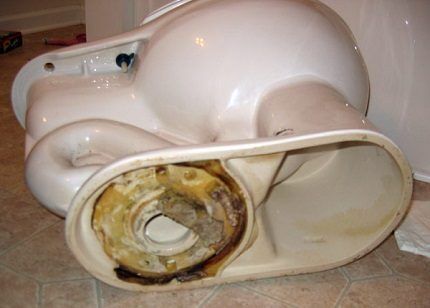
You need to remove water from the bowl.To do this, the toilet is tilted slightly, then loosened and raised. Sometimes you can’t get by with a little bloodshed. Then, in order to quickly separate the product from the sewer pipe, you need to hit the drain neck with force. It will crack, and the remaining parts of the structure will become loose from vibration. They will be easier to remove.
He will introduce you to the details of dismantling old plumbing fixtures next article, which we highly recommend reading.
Stage 2: marking and preparation
It is better to install a new toilet in place of the old one, because... transfer of communications from replacing toilet pipes - The work is not easy and time-consuming. To complete it, you need skills and experience. Before installing the product, the surfaces should be thoroughly cleaned and leveled.
The installation site is measured and the location of the plumbing and sewer pipes is outlined. According to the finished marking, a screw flange with a lock is inserted.
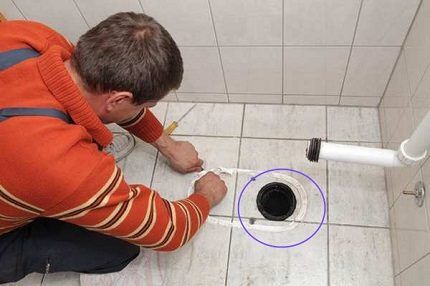
A standard screw flange has a round hole into which the end of the sewer pipe is secured. After fixing it, all that remains is to make sure that everything is done correctly and that the surfaces are clean and prepared for installation of the plumbing fixture.
Stage 3: toilet installation
If everything is perfectly prepared, the vertical flush device is installed with a “light movement of the hand.” The product is simply placed on the flange so that the mating part is located strictly above the opening of the sewer pipe. Then the toilet is turned slightly so that the latch works.
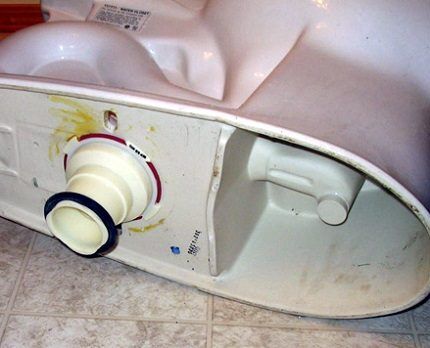
At the moment of rotation, the flange presses the outlet pipe of the device against the sealing ring. The connection is completely sealed. If everything is done carefully, leaks are excluded, because The seal reliably compresses the toilet outlet, eliminating possible gaps.
Stage 4: connecting to the water supply
All that remains is to assemble the tank and install it in it drainage fittings and finish connecting it. This is done using the so-called. water outlets, which are provided in all bathrooms. Taps are put on them and sealed with fum tape.
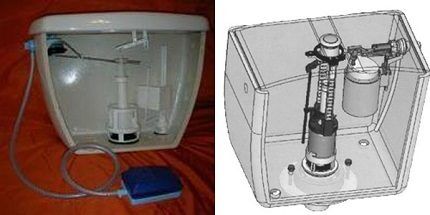
One end of the supply hose is connected to the outlet of the faucet, and the other to the outlet of the drain tank. All joints are carefully sealed. When the work is finished, all that remains is to check the functionality of the toilet.
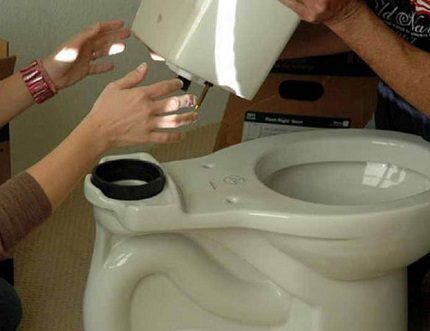
Open the water supply tap, wait until the tank is full, and then press the drain button. At this time, feel the joints and rub them with a dry white cloth. If there are no traces of moisture, everything is in order: the toilet is completely ready for its intended use.
Replacement with a model with a different drain
Is it possible to replace a device with a vertical outlet with a model with a different type of drain? Yes, if the area and location of the plumbing allow you to move the toilet by at least 15-20 cm. To connect to the sewer you will need plumbing corrugation.
Work order:
- The old toilet is being dismantled. A new one is placed in its place so that it is as close as possible to the sewer pipe.
- The pipe of the device is coated with silicone sealant, and a corrugation is put on it.
- The second end of the corrugation is inserted into the sewer pipe and fixed.
The folds of the corrugation should straighten without dents. It is necessary to ensure that its slope is directed towards the sewer pipe.
How to properly care for a new device?
Plumbers recommend installing coarse filters along with the new toilet. Tap water contains solid particles and pieces of scale from metal pipes. Getting into the tank along with debris, it provokes abrasion and premature wear of parts.
If the filter is not installed, you should take care to timely clean the drain tank so that you do not have to repair or replace damaged elements ahead of time. The structure is disassembled, limescale is removed, and the parts are washed with clean water.
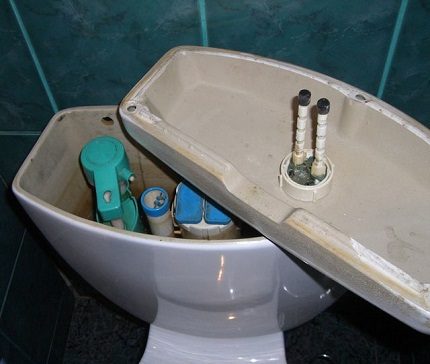
To avoid leaks at the junction with the sewer, preventive maintenance must be carried out. A pipe cleaning chemical (“Mr. Muscle”, Tiret, “Chister” or any other) is poured into the toilet and left for the time indicated on the package.Aggressive substances corrode plaque on the walls, which prevents blockages.

You need to clean the toilet at least a couple of times a year. It is important to choose the right cleaners taking into account the characteristics of the materials from which the pipes and the device itself are made.
Conclusions and useful video on the topic
The structure must be installed in such a way that it operates smoothly and does not create problems for the user or neighbors. We offer several video tutorials that will be useful for a novice plumber.
Video #1. Detailed video tutorial on how to install the structure:
Video #2. Installation steps for a device with vertical outlet:
Video #3. The nuances of connecting to the sewer system:
There is nothing complicated about installing a toilet. To get the job done, a standard set of tools, which is found in almost every home, and skills in handling them are enough.
The main thing is the correct choice of technology, accuracy of operations, reliable waterproofing and strength of connections. If difficulties arise, call a plumber.
Please write comments in the block below, post photos and ask questions about the topic of the article. Tell us about how you installed a toilet with a vertical pipe to connect to the sewer in your country house, share useful information. It is possible that your advice will be useful to site visitors.




A huge advantage of compacts with vertical outlet is that neither corrugations nor sewer pipes are visible from behind. It will definitely be much more aesthetically pleasing!
The quality of operation and water drainage is not affected by the type of outlet, so choose the toilet that you like best and that you can afford! There are more important characteristics in compacts that you should focus on!
A toilet with a floor outlet, of course, is aesthetically pleasing and all that, but this variation can be installed without any difficulties only if you plan in advance to purchase exactly this type of toilet and install it simultaneously with the renovation of the bathroom. In this case, you will have to raise the floor quite a lot, creating a step into the toilet room, which you will always have to remember. In a private house this is easier, where the floors can be lowered or raised according to your design, and in general there are much more possibilities. Personally, I wouldn’t buy such a toilet for an apartment because it would be too much of a hassle.
Well, yes, I have never seen vertical flushes in apartments. Maybe there is one somewhere in new buildings, but if it’s an old foundation, then it’s always and definitely a mess with re-cutting. In general, I don’t see the need to buy a vertical flush if there is practically no difference in the flushes.
Well, this is where the cards fall. If the pipes already run under the floor, then why experiment and buy a toilet with a flush other than a vertical one? Otherwise, I would have entrusted the re-cutting only to a qualified specialist, and I would never have bothered to do it myself for anything in my life. In short, I am in favor of adapting to the location of the pipe, and not hammering the floor like a sheep, laying a drain pipe, cutting into it, etc., just to make the toilet look more aesthetically pleasing.
This is for practical people who are used to getting optimal results with minimal investment in time and money. But for many, design and interior are also very important; such people will redo the insert and the layout as a whole, without noticing any problem.
At work, I often come across cases where design comes before practical solutions, the same wall-hung toilets in small toilets, where it’s simply impossible to turn around, but the client wants it and that’s it. Vertical drainage is the most common option today, which is easy to install and does not require additional costs, and is also quite simple to maintain. Communications are hidden, but can be easily accessed if necessary.